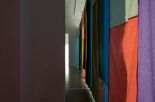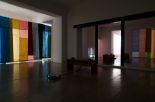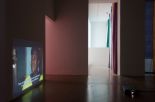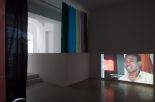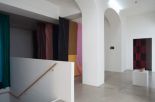| 29.06. - 25.08.2012 | Gitte Villesen |
|
Fotos: Christine Winkler | Courtesy: Grazer Kunstverein
as there was nothing in between
Eröffnung | Opening (scroll down for english version)
Die dokumentarischen Videoarbeiten und Installationen der dänischen Künstlerin Gitte Villesen (*1965) können im weitesten Sinne als Portraits verstanden werden: Sie erkunden die Form, in der Einzelne oder auch soziale Gruppen ihrem Leben im Rahmen ihrer kulturellen Möglichkeiten Gestalt verleihen. Ihre Protagonisten erscheinen dabei weder als heroische Subjekte noch als Opfer der Umstände. Vielmehr macht Villesen deutlich, wie sich bestimmte Lebensentwürfe in einer alltäglichen Mikropolitik der Gesten, Gewohnheiten und Rituale im Spannungsverhältnis zwischen Norm und Abweichung konstituieren. Zugleich vermeidet sie mit großer Umsicht soziale Verallgemeinerungen, indem sie die Praxis des Dokumentierens selbst als Austausch und Begegnung situiert - als eine spezifische Form der sozialen Interaktion, in der nicht zuletzt auch die Formen der Repräsentation zum Gegenstand der Verhandlung werden. Gitte Villesens Ausstellung im Grazer Kunstverein konzentriert sich auf zwei raumgreifende Videoinstallationen, die im Rahmen ihres seit 2008 verfolgten Langzeitprojekts um die Figur des gambischen Musikers Amadou Sarr und seine familiären Netzwerke entstanden sind. Im Zentrum dieser Arbeiten steht Villesens Interesse an den rituellen Praktiken und sozialen Funktionen des JuJu, einer westafrikanischen Kultur der weißen Magie, die dem ‚aufgeklärten’ westeuropäischen Blick fremd sein muss. Villesens Arbeiten nähern sich dieser Kultur und ihren Protagonisten weder in der distanziert-objektivierenden Perspektive des Ethnographen, noch über exotistische Formen der Überidentifikation. Vielmehr bedient sie sich mit ihrer Strategie des ‚story-telling’, des Geschichtenerzählens, einer kulturellen Form, die einen geteilten Raum der Interaktion eröffnet, der ohne die Kategorie der Distanz auf der einen und der der Identifikation auf der anderen Seite auskommt. In den ersten beiden Räumen des Kunstvereins präsentiert die Mehrkanalinstallation „I will Arrange Everything...“ (2009/10) so die Geschichten von drei mit Amadour Sarr verwandten Frauen aus unterschiedlichen Generationen: Mariama Senghor, Amadous dritte Frau, Mariama Corr, ihre Mutter sowie deren Mutter Yenden Joff. Jede der drei Portraitierten erzählt für und vor Gitte Villesens Kamera ein für ihr Leben und Selbstverständnis einschneidendes Ereignis, in der die Kultur des JuJu eine zentrale Rolle spielt: Einerseits als Form weiblicher Selbstermächtigung, die die gegebenen kulturellen Grenzen punktuell überschreitet. Anderseits wird aber zugleich auch deutlich, dass dieses Moment der Überschreitung kultureller Grenzen mit Formen der sozialen Kontrolle einhergeht, die den Frauen wiederum ihren Platz in der Gesellschaft zuweisen. Gitte Villesens neue Videoarbeit im hinteren Raum des Kunstvereins macht dann das ‚story-telling’ selbst zum Gegenstand der dokumentarischen Reflektion. In „I had no other Chance but to Jump...“ (2012) trägt Amadou Sarr auf seinem Molo – einem Saiteninstrument, dem magische Eigenschaften zugesprochen werden – ein traditionelles Stück vor, das den Wettstreit zweier konkurrierender Geschichten als Schöpfungsmythos erzählt. Hier stellt sich weniger die Frage, ob diese Geschichten wahr sind oder nicht, sondern vielmehr, wer die bessere Geschichte erzählt. Mit dem installativen Element der Vorhänge extrapoliert Gitte Villesen in der Ausstellung zudem konsequent ihr Verständnis von Dokumentarismus als kooperativer sozialer Praxis in den Bereich des Räumlich-Materiellen: Die Vorhänge werden als Auftragsarbeiten von Mariama Corr, eine ihrer Protagonistinnen, für ihre jeweiligen Projekte angefertigt, sie strukturieren den Raum und geben ihren Bildern einen Ort.
Gitte Villesens Videoarbeit „I had no other Choice than to Jump from one Pile to the Other, as there was Nothing in between“ (2012) wurde vom Grazer Kunstverein und dem Dänischen Nationalmuseum in Kopenhagen koproduziert.
Veranstaltungen
CMRK Shuttleservice Wien - Graz - Wien
Ausstellungen im Dialog
(English version)
The documentary videos and installations by the Danish artist Gitte Villesen (*1965) can be understood as portraits in the broadest sense: they explore the form in which individuals or social groups shape their lives within the framework of their cultural possibilities. Yet their protagonists appear neither as heroic subjects nor as victims of circumstances. Instead, Villesen illuminates how subjects and identities are constituted in the everyday micro-politics of gestures, habits and rituals in the charged relationship between norm and deviation. At the same time, she carefully avoids social generalizations by situating the practice of documenting itself as exchange and encounter – as a specific form of social interaction, in which, not least of all, the forms of representation always become the subject of negotiation as well. Gitte Villesen’s exhibition at Grazer Kunstverein is concentrated in two expansive video installations. They were both made in conjunction with the long-term project she has conducted since 2008 about the figure of the Gambian musician Amadou Sarr and his family network. These works center around Villesen’s interest in the ritual practices and social functions of JuJu, a West African culture of white magic, which must appear alien to the “enlightened” Western European gaze. Villesen’s works approach this culture and its protagonists neither through the distanced, objectifying perspective of an ethnographer, nor through exoticist forms of over-identification. Instead, she makes use of a strategy of story-telling as a cultural form that opens up a shared space of interaction that dispenses with the category of distance on the one side and identification on the other. In the first of the two rooms of the Kunstverein, the multi-channel installation “I will Arrange Everything...” (2009/10) thus presents the stories of three women from different generations, who are related to Amadou Sarr: Mariama Senghor, Amadou’s third wife, Mariama Corr, her mother, and her mother Yenden Joff. For and in front of Gitte Villesen’s camera, each of the three women portrayed tells of an occurrence that was decisive for her life and self-understanding, in which the culture of JuJu plays a central role: on the one hand as female self-empowerment, which transgresses the given cultural boundaries in certain points. On the other hand, however, it also becomes clear at the same time that this moment of transgression goes hand in hand with forms of social control, which in turn assign the women to their place in society. Gitte Villesen’s new video work in the second room of the Kunstverein then turns the strategy of story-telling itself into the subject of documentary reflection. In “I had no other Chance but to Jump...” (2012) Amadou Sarr performs a traditional piece on his molo – a string instrument said to have magical properties – that tells of the contest between two competing stories as creation myths. The question here is not so much whether the stories are true or not, but rather who tells the better story. With the installative element of the curtains in the exhibition, Gitte Villesen extrapolates her understanding of documentarism as a cooperative social practice in the field of the spatial-material: Mariama Corr, one of the protagonists, was commissioned to make the curtains for each of Villesen’s projects. They structure the space and give the images a place.
Events CMRK Shuttle service Vienna - Graz - Vienna
Exhibitions in dialogue
|


